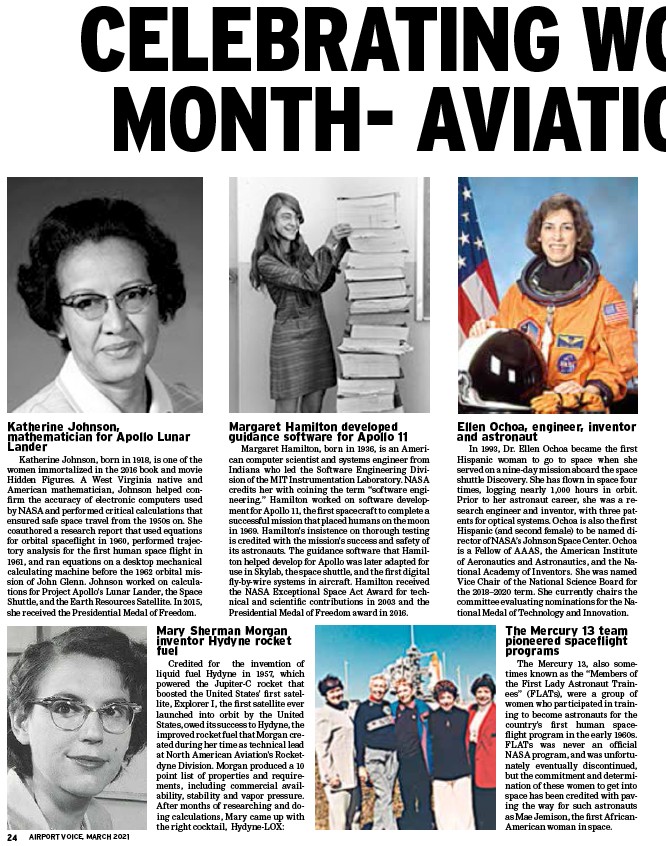
CELEBRATING WOMEN’S MONTH- AVIATION Mary Sherman Morgan
Katherine Johnson,
mathematician for Apollo Lunar
Lander
Katherine Johnson, born in 1918, is one of the
women immortalized in the 2016 book and movie
Hidden Figures. A West Virginia native and
American mathematician, Johnson helped confirm
the accuracy of electronic computers used
by NASA and performed critical calculations that
ensured safe space travel from the 1950s on. She
coauthored a research report that used equations
for orbital spaceflight in 1960, performed trajectory
analysis for the first human space flight in
1961, and ran equations on a desktop mechanical
calculating machine before the 1962 orbital mission
of John Glenn. Johnson worked on calculations
for Project Apollo's Lunar Lander, the Space
Shuttle, and the Earth Resources Satellite. In 2015,
she received the Presidential Medal of Freedom.
24 AIRPORT VOICE, MARCH 2021
Margaret Hamilton developed
guidance software for Apollo 11
Margaret Hamilton, born in 1936, is an American
computer scientist and systems engineer from
Indiana who led the Software Engineering Division
of the MIT Instrumentation Laboratory. NASA
credits her with coining the term “software engineering.”
Hamilton worked on software development
for Apollo 11, the first spacecraft to complete a
successful mission that placed humans on the moon
in 1969. Hamilton's insistence on thorough testing
is credited with the mission's success and safety of
its astronauts. The guidance software that Hamilton
helped develop for Apollo was later adapted for
use in Skylab, the space shuttle, and the first digital
fly-by-wire systems in aircraft. Hamilton received
the NASA Exceptional Space Act Award for technical
and scientific contributions in 2003 and the
Presidential Medal of Freedom award in 2016.
inventor Hydyne rocket
fuel
Credited for the invemtion of
liquid fuel Hydyne in 1957, which
powered the Jupiter-C rocket that
boosted the United States' first satellite,
Explorer I, the first satellite ever
launched into orbit by the United
States, owed its success to Hydyne, the
improved rocket fuel that Morgan created
during her time as technical lead
at North American Aviation's Rocketdyne
Division. Morgan produced a 10
point list of properties and requirements,
including commercial availability,
stability and vapor pressure.
After months of researching and doing
calculations, Mary came up with
the right cocktail, Hydyne-LOX:
Ellen Ochoa, engineer, inventor
and astronaut
In 1993, Dr. Ellen Ochoa became the first
Hispanic woman to go to space when she
served on a nine-day mission aboard the space
shuttle Discovery. She has flown in space four
times, logging nearly 1,000 hours in orbit.
Prior to her astronaut career, she was a research
engineer and inventor, with three patents
for optical systems. Ochoa is also the first
Hispanic (and second female) to be named director
of NASA’s Johnson Space Center. Ochoa
is a Fellow of AAAS, the American Institute
of Aeronautics and Astronautics, and the National
Academy of Inventors. She was named
Vice Chair of the National Science Board for
the 2018–2020 term. She currently chairs the
committee evaluating nominations for the National
Medal of Technology and Innovation.
The Mercury 13 team
pioneered spaceflight
programs
The Mercury 13, also sometimes
known as the “Members of
the First Lady Astronaut Trainees”
(FLATs), were a group of
women who participated in training
to become astronauts for the
country's first human spaceflight
program in the early 1960s.
FLATs was never an official
NASA program, and was unfortunately
eventually discontinued,
but the commitment and determination
of these women to get into
space has been credited with paving
the way for such astronauts
as Mae Jemison, the first African-
American woman in space.